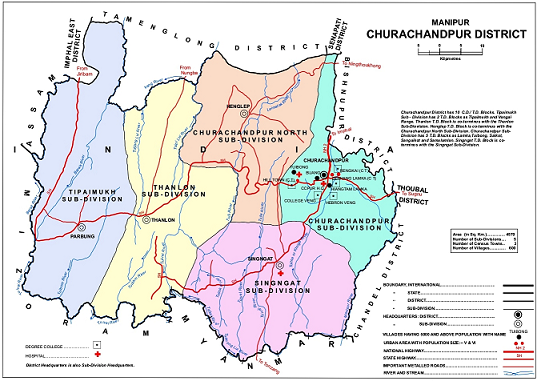
ICAR Research Complex for NEH Region, Manipur Centre

District Profile
- KVK Churachandpur, Pearsonmun lies on the south-western part of Manipur between 24.0 N and 24.3 N latitude and 93.15 E and 94.0 E longitude. The average altitude of the district is 1000.0 metres above the mean sea level. The maximum temperature is 370C while the minimum is 10C. The highest rainfall is 3080 mm the lowest is 597 mm. The maximum humidity is 100% and the minimum 61%. The beauty of the landscape is supplemented by the climate which is temperate and salubrious. The winter extending from November to February is cold, particularly in the hills but days are bright and sunny. The monsoon months stretch from May-June to September with heavy showers almost throughout the period. The spring and summer months are mildly pleasant despite high humidity.

District Agriculture Profile: Agricultural and related activities occupy the most important place in the economy of the district. Being the main source of livelihood of the people the entire economy of the district depends on the success or failure of food crops. Rice and maize are the two major crops of the district. Rice is cultivated on the slopes of hills by means of two methods namely, Jhum and terraced cultivation. For the purpose of Jhum cultivation, a plot of land is selected and the trees and vegetations growing on it are slashed and cleared. Then fire is set., burning the dry woods and vegetations then crops are grown. Rain is the only source of water and production is very low. The land thus brought under cultivation is used as long as it is fertile and productive. When the top soil is finally washed away and the soil become no longer productive the cultivation is shifted to another place after the same procedures. In recent years as the pressure on land increases, the jhum cycle has been reduced from 19/9 years to 5/4 years. There are pockets of foothills where the slopes are not so steep and where terraced cultivation is practiced. Stream and spring waters are generally used for irrigating such cultivation. There are some areas in and around Chrachandpur – Khuga Valley where wet rice cultivation is practiced. The area under rice cultivation in 2006-20007 is estimated at 13.73 thousands hectors, with an estimated yield of 25.01 thousand tonnes while the corresponding figures for maize in that year is 0.84 hectors, and 1.03 thousand tonnes respectively. Distribution of fertilizer (all sorts) is estimated at 505 tones, pulses, potato, pea, soya been, ginger, pineapple and chillier are other agricultural products which are highly of good taste and also exported to other districts. Among vegetable mention may be made of Cabbage, Cauliflower, Brinjals, Tree-Bean (Yongchak) Tomatoes and wide variety of edible vegetables grown in the wild hills. Citrus fruits such as Lime, Lemon and Orange are found in plenty in Tipaimukh sub-division. Because of poor communication system these fruits cannot reach the district headquarters and, therefore, exported to Silchar and its adjoining areas by boats through the Barak river. Other fruits products are Guava, Papaya, Banana, Pear, Umla Plum etc. Three Progeny Orchard farms at Chrachandpur (Tuibong), Thanlon and Tinsong are responsible for distribution of fruit saplings to the needy farmers. To check soil erosion caused by shifting cultivation and to conserve soil programmes on afforestation social forestry and permanent settlement of Jhumia families have already been taken up. The district has a partial share of afforstation programme in the catchments area of Loktak Hydro Electric Project.
VETRINARY & ANIMAL HUSBANDRY : In 2008-2009, the district boasts of having 5 Nos. of District Veterinary Hospital, 8 Veterinary Dispensaries, 7 Aid Centres, 3 cross breeding Sub centres, 1 Epidemic Control Unit, 1 piggery farm. The district has 1 Artificial Insemination Centre where 90 A.I. done in 2006-2007. 39,880 cases were treated in 2008-2009. The breakup of livestock population (2003 Census) is as follows :(a) Cattle –22,570, (b) Buffaloes – 5,413, (c) Sheep – 739, (d) Goats – 4,007, (e) Horses and Ponies – 310, (f) Pigs – 31,039, (g) Dogs – 12,110, (h) Mithuns – 1,305 and (i) Rabbits166. Among the livestock Pig constitutes the highest population followed by cattle. The two are reared mainly for home consumption and for marketing. Cattle and buffaloes are reared also for ploughing paddy fields. Earlier poultry farming in the district are mainly for consumption but recent years peoples taken it as economic generation. Source: District Census Handbook Churachandpur 2011
KVK at a Glance
Projects
- NICRA
- NARI
- CFLD Oilseed
- CFLD Pulse
- ARYA
Telephone Directory
- Director ICAR - ATARI Umiam
- Vice Chancellors of Agricultural Universities (SAU/CAU etc.)
- Directors of ICAR Institutes Having KVK
- Director of Extension Education
- Chairman of NGOS
- KVK Staff Details
- Telephone Directory of KVKs and Others
Quick Links
- Portal
- Important Links
- Release / Order / Circulars
- Adopted Village
- Awards
- Programmes
- Annual Action Plan
- Impact
- Vigilance Officer
- Proceedings
Social Media
